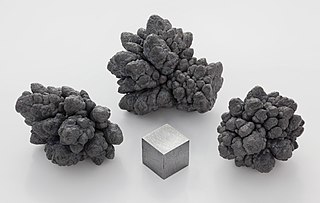Related Research Articles

Lead is a chemical element with the symbol Pb and atomic number 82. It is a heavy metal that is denser than most common materials. Lead is soft and malleable, and also has a relatively low melting point. When freshly cut, lead is a shiny gray with a hint of blue. It tarnishes to a dull gray color when exposed to air. Lead has the highest atomic number of any stable element and three of its isotopes are endpoints of major nuclear decay chains of heavier elements. Lead is toxic, even in small amounts, especially to children.

Pollution is the introduction of contaminants into the natural environment that cause adverse change. Pollution can take the form of any substance or energy. Pollutants, the components of pollution, can be either foreign substances/energies or naturally occurring contaminants.

Smoke is a suspension of airborne particulates and gases emitted when a material undergoes combustion or pyrolysis, together with the quantity of air that is entrained or otherwise mixed into the mass. It is commonly an unwanted by-product of fires, but may also be used for pest control (fumigation), communication, defensive and offensive capabilities in the military, cooking, or smoking. It is used in rituals where incense, sage, or resin is burned to produce a smell for spiritual or magical purposes. It can also be a flavoring agent and preservative.

Thomas Midgley Jr. was an American mechanical and chemical engineer. He played a major role in developing leaded gasoline and some of the first chlorofluorocarbons (CFCs), better known in the United States by the brand name Freon; both products were later banned from common use due to their harmful impact on human health and the environment. He was granted more than 100 patents over the course of his career.

Tetraethyllead (commonly styled tetraethyl lead), abbreviated TEL, is an organolead compound with the formula Pb(C2H5)4. It is a fuel additive, first being mixed with gasoline beginning in the 1920s as a patented octane rating booster that allowed engine compression to be raised substantially. This in turn increased vehicle performance and fuel economy. TEL was first synthesised by German chemist Carl Jacob Löwig in 1853. American chemical engineer Thomas Midgley Jr., who was working for General Motors, was the first to discover its effectiveness as an antiknock agent in 1921, after spending several years attempting to find an additive that was both highly effective and inexpensive.

Lead poisoning, also known as plumbism and saturnism, is a type of metal poisoning caused by lead in the body. The brain is the most sensitive. Symptoms may include abdominal pain, constipation, headaches, irritability, memory problems, infertility, and tingling in the hands and feet. It causes almost 10% of intellectual disability of otherwise unknown cause and can result in behavioral problems. Some of the effects are permanent. In severe cases, anemia, seizures, coma, or death may occur.

Water pollution is the contamination of water bodies, usually as a result of human activities, so that it negatively affects its uses. Water bodies include lakes, rivers, oceans, aquifers, reservoirs and groundwater. Water pollution results when contaminants mix with these water bodies. Contaminants can come from one of four main sources: sewage discharges, industrial activities, agricultural activities, and urban runoff including stormwater. Water pollution is either surface water pollution or groundwater pollution. This form of pollution can lead to many problems, such as the degradation of aquatic ecosystems or spreading water-borne diseases when people use polluted water for drinking or irrigation. Another problem is that water pollution reduces the ecosystem services that the water resource would otherwise provide.
Kevin Drum is an American journalist. Drum initially rose to prominence through the popularity of his independent blog Calpundit (2003–2004). He later was invited to launch a blog, Political Animal (2004–2008), for the Washington Monthly. In 2008, he took a writing and blogging position at Mother Jones magazine. He was born in Long Beach, California and currently lives in Irvine, California.

Lead paint or lead-based paint is paint containing lead. As pigment, lead(II) chromate, lead(II,IV) oxide,, and lead(II) carbonate are the most common forms. Lead is added to paint to accelerate drying, increase durability, maintain a fresh appearance, and resist moisture that causes corrosion. It is one of the main health and environmental hazards associated with paint. Lead paint has been generally phased out of use due to the toxic nature of lead. Alternatives such as water-based, lead-free traffic paint are readily available.
In the United States, the relationship between race and crime has been a topic of public controversy and scholarly debate for more than a century. Crime rates vary significantly between racial groups. Academic research indicates that the over-representation of some racial minorities in the criminal justice system can in part be explained by socioeconomic factors, such as poverty, exposure to poor neighborhoods, poor access to public and early education, and exposure to harmful chemicals and pollution. Racial housing segregation has also been linked to racial disparities in crime rates, as Blacks have historically and to the present been prevented from moving into prosperous low-crime areas through actions of the government and private actors. Various explanations within criminology have been proposed for racial disparities in crime rates, including conflict theory, strain theory, general strain theory, social disorganization theory, macrostructural opportunity theory, social control theory, and subcultural theory.

Pollution in China is one aspect of the broader topic of environmental issues in China. Various forms of pollution have increased as China has industrialised, which has caused widespread environmental health problems.

Air pollution is the contamination of air due to the presence of substances in the atmosphere that are harmful to the health of humans and other living beings, or cause damage to the climate or to materials. It is also the contamination of indoor or outdoor surrounding either by chemical activities, physical or biological agents that alters the natural features of the atmosphere. There are many different types of air pollutants, such as gases, particulates, and biological molecules. Air pollution can cause diseases, allergies, and even death to humans; it can also cause harm to other living organisms such as animals and food crops, and may damage the natural environment or built environment. Air pollution can be caused by both human activities and natural phenomena.

Sentinel species are organisms, often animals, used to detect risks to humans by providing advance warning of a danger. The terms primarily apply in the context of environmental hazards rather than those from other sources. Some animals can act as sentinels because they may be more susceptible or have greater exposure to a particular hazard than humans in the same environment. People have long observed animals for signs of impending hazards or evidence of environmental threats. Plants and other living organisms have also been used for these purposes.

Environmental epidemiology is a branch of epidemiology concerned with determining how environmental exposures impact human health. This field seeks to understand how various external risk factors may predispose to or protect against disease, illness, injury, developmental abnormalities, or death. These factors may be naturally occurring or may be introduced into environments where people live, work, and play.

The correlates of crime explore the associations of specific non-criminal factors with specific crimes.
Green criminology is a branch of criminology that involves the study of harms and crimes against the environment broadly conceived, including the study of environmental law and policy, the study of corporate crimes against the environment, and environmental justice from a criminological perspective.

The lead–crime hypothesis is a research area that involves a study of the correlation between elevated blood lead levels in children and increased rates of crime, delinquency, and recidivism later in life.

The crime drop or crime decline is a pattern observed in many countries whereby rates of many types of crime declined by 50% or more beginning in the mid to late 1980s and early 1990s.
Adrian Gerard Barnett is a professor in the faculty of Health in the school of Public Health and Social Work, at Queensland University of Technology and was president of the Statistical Society of Australia from 2018–2020.
Jerome Okon Nriagu is a Nigerian-born, American environmental chemist, academic and researcher. He is Professor Emeritus in the School of Public Health at the University of Michigan. He was formerly a Research Scientist at Environment Canada in the former National Water Research Institute, Burlington, Ontario, and an Adjunct Professor in the Department of Earth Sciences, University of Waterloo, Canada.
References
- ↑ "Riehl World View: Lead Poisoning And Crime".
- ↑ Nevin, Rick (May 2000). "How Lead Exposure Relates to Temporal Changes in IQ, Violent Crime, and Unwed Pregnancy" (PDF). Environmental Research. 83 (1): 1–22. Bibcode:2000ER.....83....1N. doi:10.1006/enrs.1999.4045. PMID 10845777. S2CID 18983793.
- ↑ Nevin, Rick (July 2007). "Understanding international crime trends: The legacy of preschool lead exposure" (PDF). Environmental Research. 104 (3): 315–336. Bibcode:2007ER....104..315N. doi:10.1016/j.envres.2007.02.008. PMID 17451672.
- ↑ Vedantam, Shankar (July 8, 2007). "Research Links Lead Exposure, Criminal Activity". Washington Post. Retrieved 2007-07-13.
- ↑ Drum, Kevin (January 2013). "Lead: America's Real Criminal Element". Mother Jones. Retrieved 1 March 2022.
- ↑ Lean, Geoffrey (October 28, 2007). "Ban on leaded petrol 'has cut crime rates around the world'". The Independent. London. Archived from the original on October 29, 2007. Retrieved 2007-12-01.
- ↑ Monbiot, George (7 January 2013). "Yes, lead poisoning could really be a cause of violent crime". The Guardian. Retrieved 3 March 2022.
- ↑ Markowitz, Gerald; Rosner, David (2014). Lead Wars The Politics of Science and the Fate of America's Children. University of California Press. p. 221. ISBN 9780520283930 . Retrieved 1 March 2022.
- ↑ Karaali, Gizem; Khadjavi, Lily S. (2021). Mathematics for Social Justice Focusing on Quantitative Reasoning and Statistics. American Mathematical Society. p. 126. ISBN 9781470449278 . Retrieved 3 March 2022.
- ↑ Regoli, Robert; Hewitt, John; DeLisi, Matt (2011). Delinquency in Society. Jones & Bartlett Learning. p. 89. ISBN 9780763777906 . Retrieved 1 March 2022.
- ↑ Siegel, Larry (February 2016). Criminology: The Core. Cengage Learning. p. 131. ISBN 9781305887336 . Retrieved 3 April 2022.
- ↑ Vito, Gennaro; Maahs, Jeffrey; Holmes, Ronald (2006). Criminology: Theory, Research, and Policy. Jones and Bartlett. p. 482. ISBN 9780763730017.
- ↑ Nielsen, Carrie (2021). Unleaded: How Changing Our Gasoline Changed Everything. Rutgers University Press. ISBN 9781978821026 . Retrieved 3 March 2022.
- ↑ Brinkmann, Robert (2020). Introduction to Sustainability (Second ed.). Wiley Blackwell. ISBN 9781119675495 . Retrieved 1 March 2022.
- ↑ Woodford, Chris (2021). Breathless: Why Air Pollution Matters and How it Affects You. London: Icon. p. 129. ISBN 9781785787102.